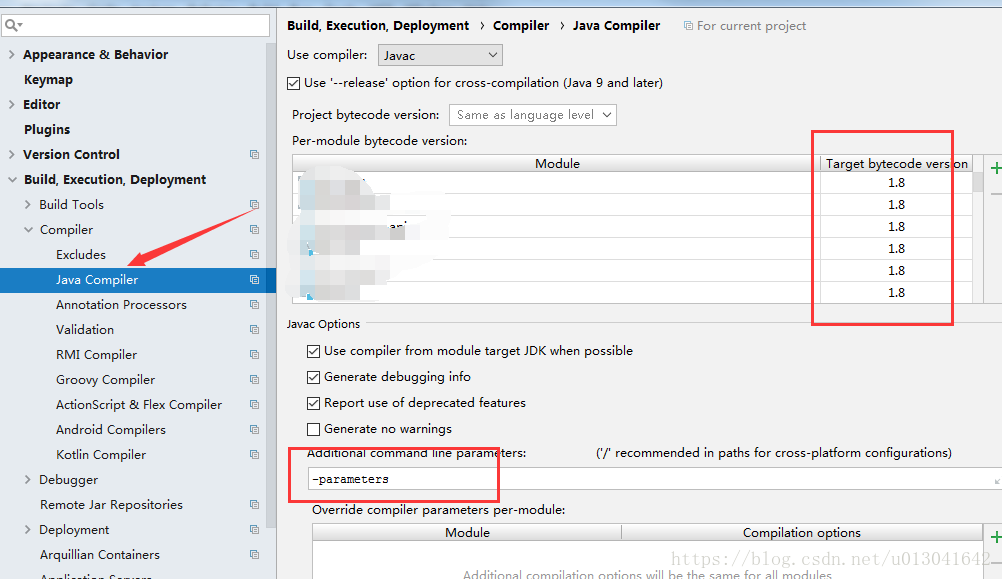这篇文章主要讲解了“SpringAOP 通过JoinPoint获取参数名和值的方法”,文中的讲解内容简单清晰,易于学习与理解,下面请大家跟着小编的思路慢慢深入,一起来研究和学习“SpringAOP 通过JoinPoint获取参数名和值的方法”吧!
在Java8之前,代码编译为class文件后,方法参数的类型固定,但是方法名称会丢失,方法名称会变成arg0、arg1….。在Java8开始可以在class文件中保留参数名。
public void tet(JoinPoint joinPoint) {
// 下面两个数组中,参数值和参数名的个数和位置是一一对应的。
Object[] args = joinPoint.getArgs(); // 参数值
String[] argNames = ((MethodSignature)joinPoint.getSignature()).getParameterNames(); // 参数名
}注意:
IDEA 只有设置了 Java 编译参数才能获取到参数信息。并且jdk要在1.8及以上版本。

增加compilerArgs 参数
<plugins>
<plugin>
<groupId>org.apache.maven.plugins</groupId>
<artifactId>maven-compiler-plugin</artifactId>
<version>${maven_compiler_plugin_version}</version>
<configuration>
<source>${java_source_version}</source>
<target>${java_target_version}</target>
<encoding>${file_encoding}</encoding>
<compilerArgs>
<arg>-parameters</arg>
</compilerArgs>
</configuration>
</plugin>
</plugins>Preferences->java->Compiler下勾选Store information about method parameters选项。
这样在使用eclipse编译java文件的时候就会将参数名称编译到class文件中。
JoinPoint对象封装了SpringAop中切面方法的信息,在切面方法中添加JoinPoint参数,就可以获取到封装了该方法信息的JoinPoint对象.
常用API
| 方法名 | 功能 |
|---|---|
| Signature getSignature(); | 获取封装了署名信息的对象,在该对象中可以获取到目标方法名,所属类的Class等信息 |
| Object[] getArgs(); | 获取传入目标方法的参数对象 |
| Object getTarget(); | 获取被代理的对象 |
| Object getThis(); | 获取代理对象 |
ProceedingJoinPoint对象是JoinPoint的子接口,该对象只用在@Around的切面方法中,
添加了以下两个方法。
Object proceed() throws Throwable //执行目标方法
Object proceed(Object[] var1) throws Throwable //传入的新的参数去执行目标方法切面类
@Aspect
@Component
public class aopAspect {
/**
* 定义一个切入点表达式,用来确定哪些类需要代理
* execution(* aopdemo.*.*(..))代表aopdemo包下所有类的所有方法都会被代理
*/
@Pointcut("execution(* aopdemo.*.*(..))")
public void declareJoinPointerExpression() {}
/**
* 前置方法,在目标方法执行前执行
* @param joinPoint 封装了代理方法信息的对象,若用不到则可以忽略不写
*/
@Before("declareJoinPointerExpression()")
public void beforeMethod(JoinPoint joinPoint){
System.out.println("目标方法名为:" + joinPoint.getSignature().getName());
System.out.println("目标方法所属类的简单类名:" + joinPoint.getSignature().getDeclaringType().getSimpleName());
System.out.println("目标方法所属类的类名:" + joinPoint.getSignature().getDeclaringTypeName());
System.out.println("目标方法声明类型:" + Modifier.toString(joinPoint.getSignature().getModifiers()));
//获取传入目标方法的参数
Object[] args = joinPoint.getArgs();
for (int i = 0; i < args.length; i++) {
System.out.println("第" + (i+1) + "个参数为:" + args[i]);
}
System.out.println("被代理的对象:" + joinPoint.getTarget());
System.out.println("代理对象自己:" + joinPoint.getThis());
}
/**
* 环绕方法,可自定义目标方法执行的时机
* @param pjd JoinPoint的子接口,添加了
* Object proceed() throws Throwable 执行目标方法
* Object proceed(Object[] var1) throws Throwable 传入的新的参数去执行目标方法
* 两个方法
* @return 此方法需要返回值,返回值视为目标方法的返回值
*/
@Around("declareJoinPointerExpression()")
public Object aroundMethod(ProceedingJoinPoint pjd){
Object result = null;
try {
//前置通知
System.out.println("目标方法执行前...");
//执行目标方法
//result = pjd.proeed();
//用新的参数值执行目标方法
result = pjd.proceed(new Object[]{"newSpring","newAop"});
//返回通知
System.out.println("目标方法返回结果后...");
} catch (Throwable e) {
//异常通知
System.out.println("执行目标方法异常后...");
throw new RuntimeException(e);
}
//后置通知
System.out.println("目标方法执行后...");
return result;
}
}被代理类
/**
* 被代理对象
*/
@Component
public class TargetClass {
/**
* 拼接两个字符串
*/
public String joint(String str1, String str2) {
return str1 + "+" + str2;
}
}测试类
public class TestAop {
@Test
public void testAOP() {
//1、创建Spring的IOC的容器
ApplicationContext ctx = new ClassPathXmlApplicationContext("classpath:bean.xml");
//2、从IOC容器中获取bean的实例
TargetClass targetClass = (TargetClass) ctx.getBean("targetClass");
//3、使用bean
String result = targetClass.joint("spring","aop");
System.out.println("result:" + result);
}
}输出结果
目标方法执行前...
目标方法名为:joint
目标方法所属类的简单类名:TargetClass
目标方法所属类的类名:aopdemo.TargetClass
目标方法声明类型:public
第1个参数为:newSpring
第2个参数为:newAop
被代理的对象:aopdemo.TargetClass@4efc180e
代理对象自己:aopdemo.TargetClass@4efc180e (和上面一样是因为toString方法也被代理了)
目标方法返回结果后...
目标方法执行后...
result:newSpring+newAop
感谢各位的阅读,以上就是“SpringAOP 通过JoinPoint获取参数名和值的方法”的内容了,经过本文的学习后,相信大家对SpringAOP 通过JoinPoint获取参数名和值的方法这一问题有了更深刻的体会,具体使用情况还需要大家实践验证。这里是亿速云,小编将为大家推送更多相关知识点的文章,欢迎关注!
亿速云「云服务器」,即开即用、新一代英特尔至强铂金CPU、三副本存储NVMe SSD云盘,价格低至29元/月。点击查看>>
免责声明:本站发布的内容(图片、视频和文字)以原创、转载和分享为主,文章观点不代表本网站立场,如果涉及侵权请联系站长邮箱:is@yisu.com进行举报,并提供相关证据,一经查实,将立刻删除涉嫌侵权内容。